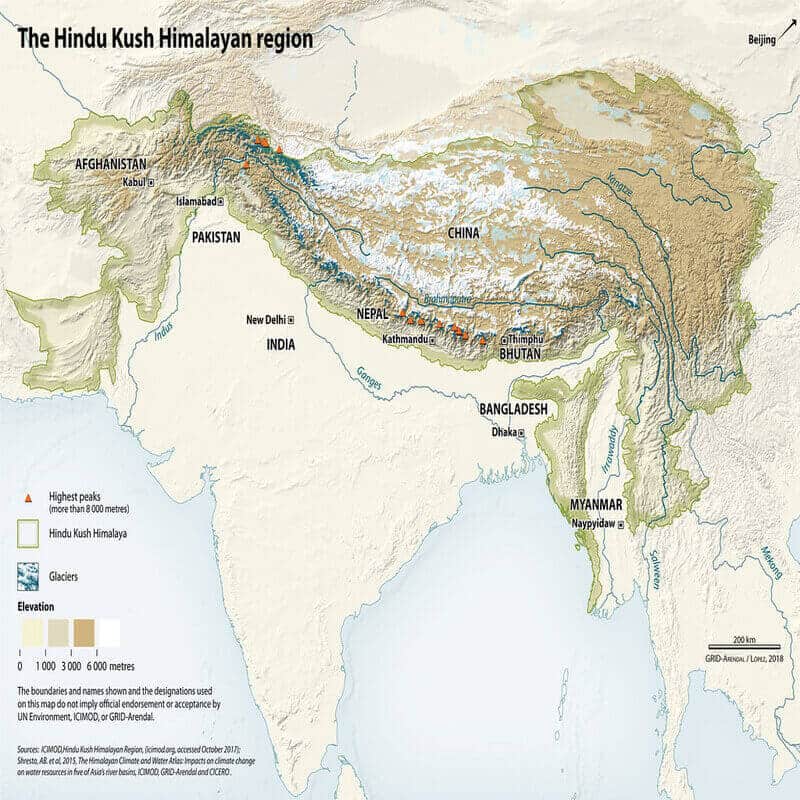
The Hindu Kush Himalayas (HKH) is a significant and expansive mountain range that spans eight Asian countries: Afghanistan, Bangladesh, Bhutan, China, India, Myanmar, Nepal, and Pakistan. Read further to learn more about the HKH.
Scientists recently declared the Hindu Kush Himalaya region a biosphere on the brink of collapse. They called for audacious action and urgent finance to prevent nature loss in one of the most biodiverse areas on Earth at a key meeting of global biodiversity experts.
The International Centre for Integrated Mountain Development (ICIMOD) issued the call as more than 130 global experts convened in Kathmandu, Nepal, for the Third Lead Authors meeting of the Intergovernmental Science-Policy Platform on Biodiversity and Ecosystem Services (IPBES) nexus assessment to examine the linkages between food and water security, health, biodiversity, and climate change.
Read: The Himalayas
Hindu Kush Himalaya

This region is often referred to as the “Third Pole” because it holds the largest reserves of ice and snow outside of the polar regions, making it a critical water source for the rivers that flow through the Asian continent.
- The HKH range is known for its rugged terrain and towering peaks, including several of the world’s highest mountains, such as Mount Everest and K2.
- The region covers approximately 4.2 million square kilometers, providing a diverse range of ecosystems from subtropical forests at lower elevations to alpine meadows and permanent ice and snow at the highest elevations.
- It is the source of ten large Asian river systems – the Amu Darya, Indus, Ganges, Brahmaputra (Yarlungtsanpo), Irrawaddy, Salween (Nu), Mekong (Lancang), Yangtse (Jinsha), Yellow River (Huanghe), and Tarim (Dayan).
Mountain ranges in HKH:
Range |
Countries |
Ganhdise Shan |
China |
Hengduan Shan |
China, Myanmar |
Himalaya |
Bhutan, China, India, Nepal, Pakistan |
Hindu Kush |
Afghanistan, Pakistan |
Karakoram |
China, India, Pakistan |
Kulun Shan |
China |
Nyainqentanglha Shan |
China |
Pamir |
Afghanistan, Pakistan, China |
Qiantang Plateau |
China |
Qilian Shan |
China |
Tanggula |
China |
Tien Shan |
China, Kyrgyzstan, Tajikistan |
Significance of the Hindu Kush Himalayas
- Water Resources: The glaciers and snowpack of the HKH are crucial sources of freshwater for the major river systems of Asia, including the Indus, Ganges, Brahmaputra, Yangtze, and Mekong. These rivers support the livelihoods of around 1.9 billion people, supplying water for drinking, irrigation, and hydropower.
- Biodiversity: The region is incredibly biodiverse, with a wide range of flora and fauna adapted to its varied climates and elevations. It is home to several globally significant biodiversity hotspots.
- Climate Regulation: The HKH plays a vital role in the regional and global climate system. The glaciers and snowfields act as a climate regulator, influencing monsoon patterns and other weather systems.
- Cultural Diversity: The region is rich in cultural diversity, with hundreds of ethnic groups residing in the HKH, each with their unique traditions, languages, and religions. This diversity is reflected in the myriad of cultural practices, festivals, and languages that enrich the Himalayan region.
Challenges Facing the Hindu Kush Himalayas
As per the Asian Development Bank, the HKH region is warming faster than the global average. If global temperature rises hit 3°C, 75% of glaciers in Bhutan and Nepal could melt by the end of the century. 70% of the original biodiversity has been lost over the last century.
- Climate Change: The impacts of climate change are profoundly felt in the HKH, with rising temperatures leading to glacier retreat, changes in snowfall patterns, and increased frequency of extreme weather events. These changes threaten water security, agriculture, and the livelihoods of millions of people.
- Environmental Degradation: Deforestation, overgrazing, unsustainable land use practices, and infrastructure development are causing environmental degradation, including soil erosion, loss of biodiversity, and water pollution.
- Socio-economic Vulnerabilities: Many communities in the HKH region face poverty, limited access to basic services, and socio-economic disparities. These vulnerabilities are exacerbated by environmental and climatic changes.
- Geopolitical Tensions: The HKH spans several countries with complex political relations, which can complicate regional cooperation on environmental conservation and sustainable development.
Conservation and Sustainable Development Efforts
Recognizing the importance and vulnerabilities of the HKH, several initiatives have been launched to promote conservation, sustainable development, and regional cooperation.
These include efforts by governments, non-governmental organizations (NGOs), international agencies, and local communities to address climate change impacts, promote sustainable livelihoods, and conserve biodiversity.
The International Centre for Integrated Mountain Development (ICIMOD) is a prominent regional organization dedicated to improving the lives of mountain people and protecting the environment in the Hindu Kush Himalayas.
India has launched a National Mission to sustain the Himalayan Ecosystem as a part of the National Action Plan on Climate Change.
Conclusion
In conclusion, the Hindu Kush Himalayas are a region of immense ecological, cultural, and geopolitical significance. The challenges facing the HKH require concerted efforts for sustainable management, conservation, and cooperation among the countries sharing this unique and vital mountain system.
Related articles:
-Article by Swathi Satish






Leave a Reply